Land Area
405,720 km2, more than three times the
total area of the Maritime Provinces (Nova Scotia, New Brunswick and
Prince Edward Island).
Newfoundland and Labrador would rank
fourth in size behind Alaska, Texas and California ... if it were one
of the United States. It is almost one-and-three-quarters times the
size of Great Britain.
Area of the Island of Newfoundland -
111,390 km2
Area of Labrador - 294,330 km2
Area of Avalon Peninsula - 9,700 km2

Water Area
34,030 km2
Coastline
Coast of Island of Newfoundland - 9,656 km
Coast of Labrador - 7,886 km Total - 17,542 km
Offshore Area
1,825,992 km2

Coat of Arms
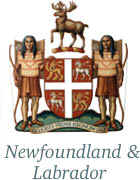
The cross is based upon the cross of St.
George, but of a different colour. The lions and unicorns are based
upon those in the Arms of England, to which the unicorn had been
added at the time of the union of England with Scotland.
The shield is surmounted by an elk and
supported on either side by people representative of the now extinct
Beothuk Indians of Newfoundland. The translation of the motto is
"Seek ye first the Kingdom of God."
Although granted in 1637, the Arms were
unknown to authorities in Newfoundland until they were rediscovered
and officially adopted by the Newfoundland Government on January 1,
1928. (Picture from House of Assembly)

Official Bird of Newfoundland
and Labrador
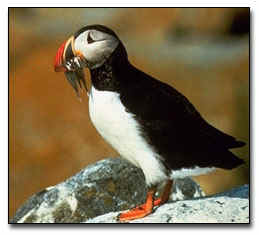
The Atlantic Puffin (Fratercula
arctica) is the provincial bird of Newfoundland and Labrador.
Some people call it the Sea Parrot or Baccalieu Bird. About 95% of all
North America's puffins breed in colonies around the Newfoundland and
Labrador coasts. As people with strong marine heritage, it is
appropriate to have a marine bird as our symbol.

Capital City
St. John's is the capital of Newfoundland and Labrador. The City's
population is 99,182, while the metro area population is about
182,485.
Other Principal Centres
Corner Brook: 20,103
Labrador City: 7,744
Grand Falls-Windsor: 13,340
Stephenville: 7,109
Gander: 9,651
Mount Pearl: 24,964
Happy Valley-Goose Bay: 7,969
Conception Bay South: 19,772
Bay Roberts: 5,237
Carbonear: 4,759
Channel-Port aux Basques: 4,637
Deer Lake: 4,769
Marystown: 5,908
Paradise: 9,598
Placentia: 4,426
Portugal Cove-St. Phillps: 5,866
Torbay: 5,474
Population
The population of Labrador is 27,105.
The population of the whole province is 515,591.

Newfoundland Coins
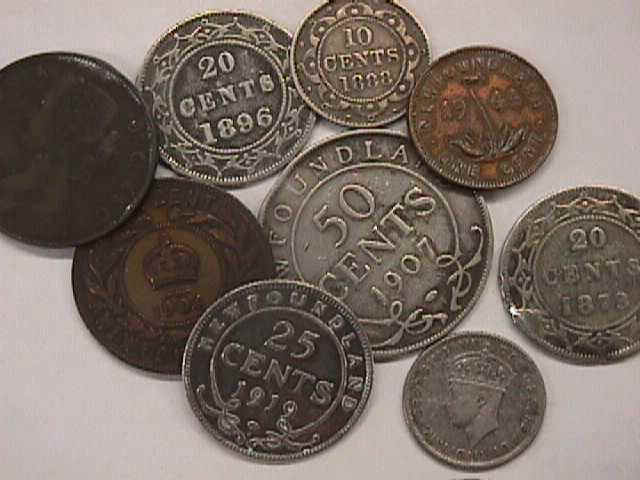
From 1834 - 1949 Newfoundland issued
her own coinage and bank notes, many of them are now valuable
collectors' items. The coin denominations issued were 1 cent, 5 cent,
10 cent, 20 cent, 25 cent, 50 cent, 2 dollar and gold. You can
purchase Newfoundland coins from many coin dealers. (Picture
from Newfoundland Museum)

Newfoundland Dogs
The Newfoundland is a large dog with
the size and strength to perform the tasks required of him. It
has a heavy coat to protect it from the long winters and the icy
waters surrounding its native island. Its feet are large, strong, and
webbed so that it may travel easily over marshes and shores.

Essentially the Newfoundland dog is as
much at home in the water as on dry land. Canine literature gives us
stories of brave Newfoundlands which have rescued men and women from
watery graves; stories of shipwrecks made less terrible by dogs that
carried life lines to stricken vessels; of children who have fallen
into deep water and have been brought safely ashore by Newfoundlands;
and of dogs whose work was less spectacular but equally valuable as
they helped their fishermen owners with their heavy nets and performed
other tasks necessary to their occupations. Although it is a
superior water dog, the Newfoundland has been used and still is used
in Newfoundland and Labrador as a true working dog, dragging carts, or
more often carrying burdens as a pack horse.
In order to perform these duties the
Newfoundland must be a large dog - large enough to bring ashore a
drowning man. It must have powerful hindquarters and a lung
capacity which enables it to swim for great distances. It
must have the heavy coat which protects it from icy waters.
In short, it must be strong, muscular, and sound so that it may
do the work for which it has become justly famous. Above all
things, the Newfoundland must have intelligence, the loyalty and the
sweetness which are its best known traits. It must be able
and willing to help its owner perform necessary tasks at command
and also have the intelligence to act on its own responsibility when
rescue work demands it.
The Newfoundland dog is mainly kept,
not as an active worker, but as a companion, guard and friend. We
appreciate particularly the sterling traits of the true Newfoundland
disposition. Here we have the great size and strength which makes it
an effective guard and watchdog combined with the gentleness which
makes it a safe companion. For generations it has been the
traditional children's protector and playmate.
We know of no better description of the
character of the Newfoundland dog than the famous epitaph which reads:
Near this spot are deposited the
remains of one who possessed Beauty without Vanity, Strength without
Insolence, Courage without Ferocity and all the Virtues of Man
without his Vices.

Provincial Flag
In this flag, the primary colours of
red, gold and blue are placed against a background of white to allow
the design to stand clearly. White is representative of snow and ice;
blue represents the sea; red represents human efforts; and gold our
confidence in ourselves. 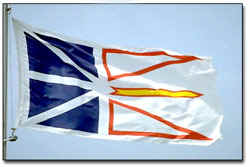 The blue section, most reminiscent of the Union Jack, represents our
Commonwealth heritage which has so decisively shaped our present. The
red and gold section, larger than the other, represents our future.
The two triangles outlined in red portray the mainland and island
parts of our province reaching forward together. A golden arrow points
the way to what we believe will be a bright future. Surrounded by red
to indicate human effort, the arrow suggests that our future is for
making and not the taking. But the design of the flag encompasses much
more symbolism than this. For example, the Christian Cross, the
Beothuk and Naskapi ornamentation, the outline of the maple leaf in
the centre of the flag, a triumphant figure and our place in the space
age. The image of a trident stands out. This is to emphasize our
continued dependence on the fishery and the resources of the sea. Hung
as a banner, the arrow assumes the aspect of a sword which is to
remind us of the sacrifice of our War Veterans. Since the whole flag
resembles a Beothuk pendant, as well as all the above, the design
takes us from our earliest beginnings and points us confidently
forward. It, therefore, mirrors our past, present and future. The flag
was officially adopted on June 6, 1980. The flag was designed by
artist Christopher Pratt.
The blue section, most reminiscent of the Union Jack, represents our
Commonwealth heritage which has so decisively shaped our present. The
red and gold section, larger than the other, represents our future.
The two triangles outlined in red portray the mainland and island
parts of our province reaching forward together. A golden arrow points
the way to what we believe will be a bright future. Surrounded by red
to indicate human effort, the arrow suggests that our future is for
making and not the taking. But the design of the flag encompasses much
more symbolism than this. For example, the Christian Cross, the
Beothuk and Naskapi ornamentation, the outline of the maple leaf in
the centre of the flag, a triumphant figure and our place in the space
age. The image of a trident stands out. This is to emphasize our
continued dependence on the fishery and the resources of the sea. Hung
as a banner, the arrow assumes the aspect of a sword which is to
remind us of the sacrifice of our War Veterans. Since the whole flag
resembles a Beothuk pendant, as well as all the above, the design
takes us from our earliest beginnings and points us confidently
forward. It, therefore, mirrors our past, present and future. The flag
was officially adopted on June 6, 1980. The flag was designed by
artist Christopher Pratt.

Floral Emblem
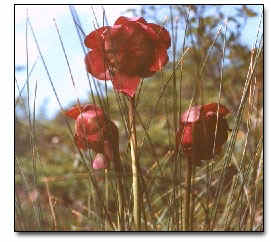
Pitcher Plant (Sarracenia purpurea).
Queen Victoria, more than a hundred years ago, chose the Pitcher Plant
to be engraved on a newly minted Newfoundland penny. In 1954, the
Newfoundland Cabinet designated this unusual and interesting plant as
the official flower of the province. It gets its nourishment from
insects that get trapped and drown in a pool of water at the base of
the tubular leaves. The flower is wine and green in colour and can be
found on bogs and marshes in Newfoundland and Labrador.

Family History Society of
Newfoundland and Labrador
A volunteer non-profit organization,
founded in 1984, incorporated in 1987. The Genealogical Resource
Centre provides access to historical databases and an information
service for genealogical researchers. Information on archives and
heritage organizations across the province.Membership is open to
anyone researching their Newfoundland ancestry. Quarterly journal The
Newfoundland Ancestor. Meetings held from September to May on the
fourth Tuesday of each month at 8 p.m. at the Arts and Culture Centre,
Allandale Road, St.John's. Indexing projects include parish
registers, cemetery transcriptions, census records and family
histories. Indexing work is carried out by volunteers all over North
America. The offices are at657 Topsail Road, St. John's. Collections
available include genealogical reference books, family histories,
cemetery transcripts, genealogical periodicals, directories and
censuses. For office hours and further information call (709)
754-9525.
Family History Society of
Newfoundland and Labrador
657 Topsail Road
St. John's, NL
A1E 2E3
Telephone: (709) 754-9525 Fax: (709) 754-6430
Office E-mail: nlgs@nf.sympatico.ca
Web Site: http://www3.nf.sympatico.ca/nlgs

Public Holidays
There are two kinds of public holidays.
New Year's Day, Good Friday, Canada Day, Labour Day, Remembrance Day,
Christmas Day and Boxing Day are traditional holidays when most stores
and offices are required to close under the Shops Closing Act. They
are celebrated on their calendar date.
On other holidays - St. Patrick's Day,
St. George's Day, Victoria Day, Orangemen's Day, Thanksgiving Day -
stores are not required to close, although many offices do under the
terms of collective agreements. In these instances, the holiday is
usually celebrated on the nearest Monday. If you are planning to
travel on a holiday, check to see that any stores or offices you plan
to visit are open.

Mineral Emblem
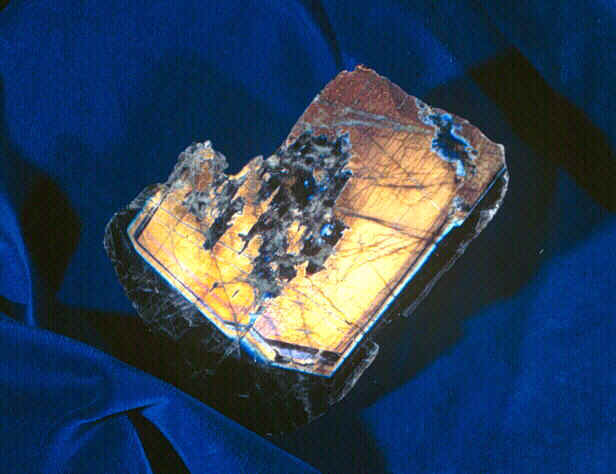
Labradorite. One of the most beautiful
and popular of the "semi-precious" stones, labradorite is
found at a number of locations on the coast of Labrador and, as well,
on the Island of Newfoundland. It is an igneous irridescent
crystalline mineral, and is also called Labrador Feldspar. It is said
that the native people of Labrador attributed mystical qualities to
the stone because of its captivating play of colours or "labradoresence."
They called it "firestone" and used a powder produced by
pulverizing it as a magical potion to cure their ailments. A
tumble-polished fragment makes an ideal touchstone or talisman and a
beautifully shaped and polished cabochon set in gold or silver is a
highly sought jewellery item in any collection. It was declared the
province's mineral emblem in 1975. Labradorite is one of about 20
semiprecious stones found in the province. (Picture from Mines &
Energy)

"Ode to
Newfoundland"
When sun-rays crown thy pine-clad hills
And summer spreads her hand,
When silvern voices tune thy rills,
We love thee, smiling land.
When spreads thy cloak of shimmering
white,
At winter's stern command,
Through shortened day and starlit night,
We love thee, frozen land.
When blinding storm gusts fret thy
shore
And wild waves lash thy strand,
Through spindrift swirl and tempest roar,
We love thee, wind-swept land,
As loved our fathers, so we love,
Where once they stood we stand,
Their prayer we raise to Heaven above,
God guard thee, Newfoundland
by Sir Cavendish Boyle

Newfoundland Pony
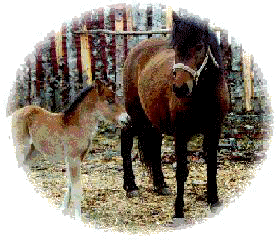
The Newfoundland Pony developed
from stock brought to the Island around 1600 from The British
Isles. Its ancestors are the ponies of Exmoor and Dartmoor in Devon,
the New Forest, and to a lesser extent the Welsh Mountain pony, the
Galloway (extinct), the Highland and the Connemara. Over the centuries
it has adapted to the conditions and climate of Newfoundland and is
virtually unknown elsewhere. Its colour can be bay, black, brown or
red with black forelocks, manes and tails. They have solid black lower
legs up to the hock on the hind leg and to the knee on the front.
Black also runs up the inside of the legs to the body. Some have a
black dorsal stripe. Their hooves are blue black with a very hard
outer horn. They weigh an average of 500 to 1000 lbs. and stand
approximately 14.2 hands (58") high. The ponies have strong front
shoulders with a good angle for a collar. His head is in proportion to
the size of the body with small erect ears and good, clear, kind eyes.
He is light and surefooted and can travel over frozen ponds and
barrens without breaking the ice. In winter their overcoats grow 2-3
inches long, usually a different colour from their summer coats. They
also grow a beard on their chins.have been used to haul boats out of
water, pull logs from the forest, and prepare land for spring
planting. They are quiet with a good temperament which makes them good
workers, easy keepers and wonderful family pets.
The Newfoundland Pony is facing
extinction through cross-breeding to other breeds and neglect. It
could quite possibly be the oldest breed of domesticated livestock in
North America. The Newfoundland government has passed legislation
declaring the pony a heritage animal. The Newfoundland Pony Society,
incorporated as a charity in 1981 is dedicated to the protection and
preservation of the Newfoundland Pony. Today there are about 150 pure
type Newfoundland Ponies. Membership, involvement, and support are
encouraged to secure this breed for the future and to save the ponies
from extinction. (Picture from Forest Resources & Agrifoods)
Newfoundland Pony Society
P.O. Box 5024
St. John's, NL A1C 5V3
Tel: (709) 738-0444
Fax: (709) 754-4212

Stamps
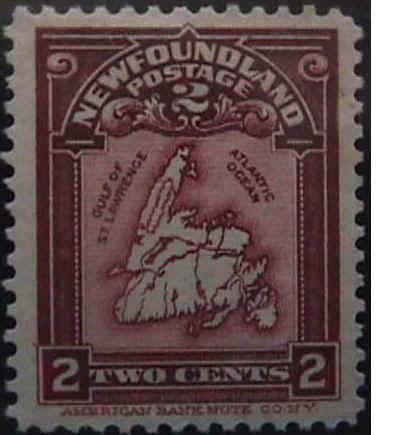
With Confederation in 1949,
Newfoundland adopted the stamps of Canada but, prior to that time,
this British Colony produced its own stamps. Newfoundland stamps are
still fairly common, especially those of the past 100 years. The
variety is rich, the stamps are colourful and the story they tell is a
fascinating one. They are also legal postage if mailed from within
Canada. Newfoundland stamps may be purchased from most stamp dealers.
(Picture from Newfoundland Museum)

Tartan
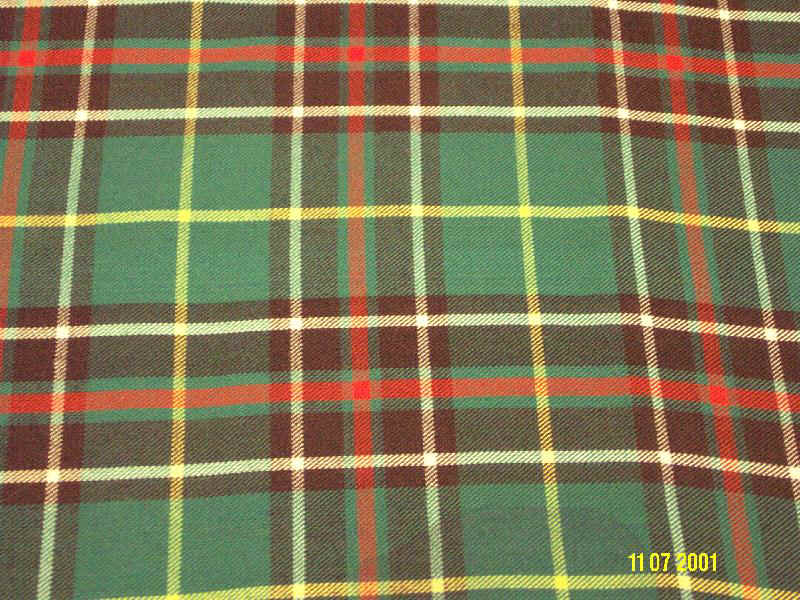
The Tartan was developed by the late
Sam Wilansky in 1955, who owned a clothing store on Water Street. The
Tartan was registered in 1973. Its colours are gold, white, borwn, and
red on a green background. The gold represents the sun's rays in the
Ode to Newfoundland; the green represents the pine clad hills; the
white represents the cloak of snow; the brown represents the Iron
Isle, a reference to Bell Island where iron was mined between the
1890s and 1960s; and the red represent the Royal Standard for which
our fathers stood.

Time Zones
The Island of Newfoundland is located in a time zone unique in North
America, half an hour later than Atlantic Time, one and a half hours
later than Central Canada and four and a half hours later than the
west coast of the country. It's the only place in Canada with a
split in the set variations of one hour between time zones. Daylight
Saving Time is observed from April to October after which the province
returns to Newfoundland Standard Time. Labrador operates on Atlantic
Time, except for the portion between L'Anse au Clair and Norman Bay,
which is on Newfoundland time.

Provincial Tree - Black Spruce
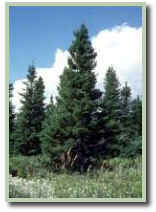
The Black Spruce (Picea mariana
(Mill.) BSP) was proclaimed the Provincial Tree of
Newfoundland & Labrador in May of 1991. This tree is widely
distributed and is the most common tree in the province. Black Spruce
has had a significant social and economic impact on the growth of the
province. It is the favoured tree in the pulp and paper industry and
is widely used for lumber, wharf piers, and firewood. Black spruce has
played a prominent role in the lives of aboriginal people and in local
folk-medicine. This enduring species is extremely hardy and flourishes
in Newfoundland and Labrador's short growing season. (Picture from
Forest Resources & Agrifoods)